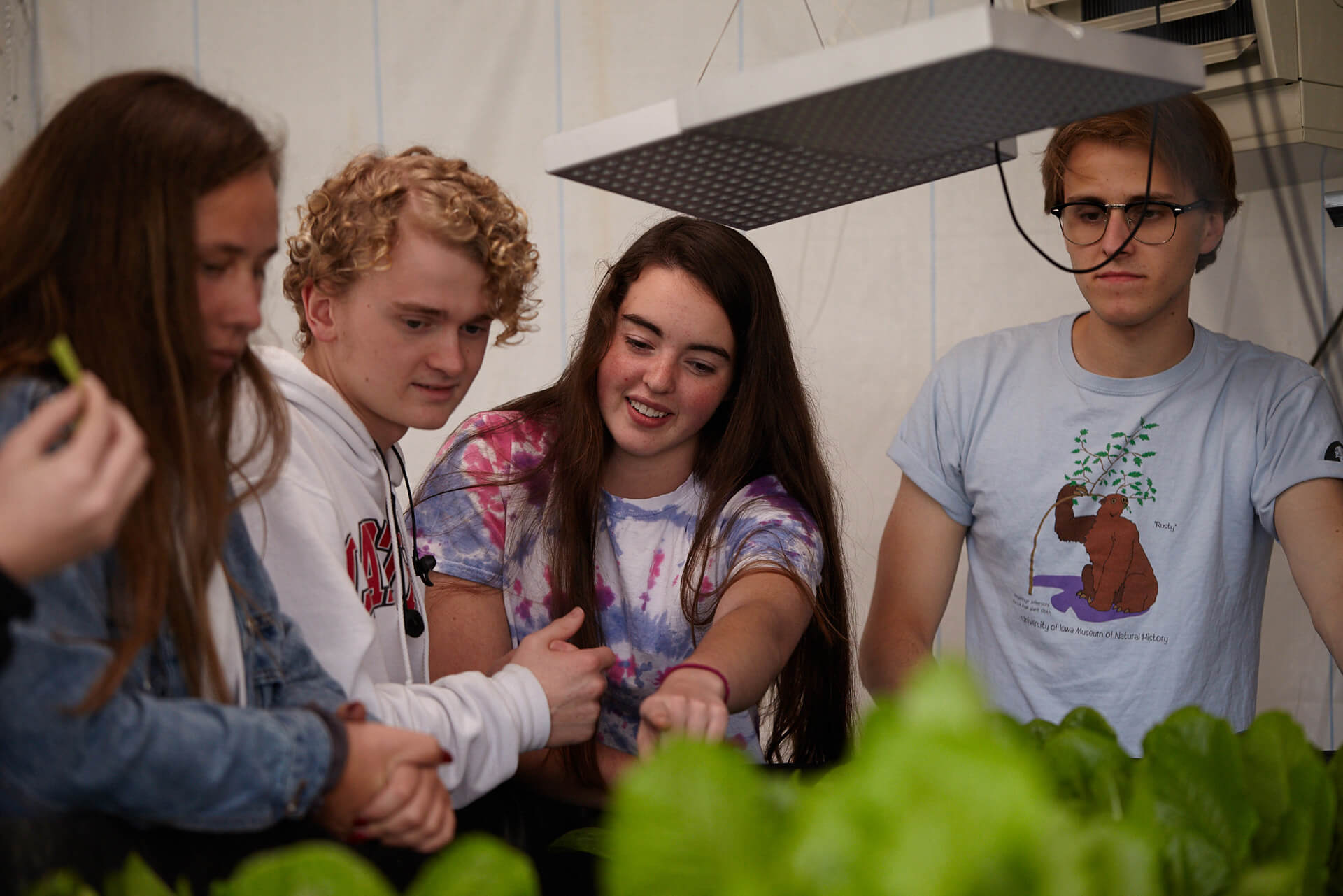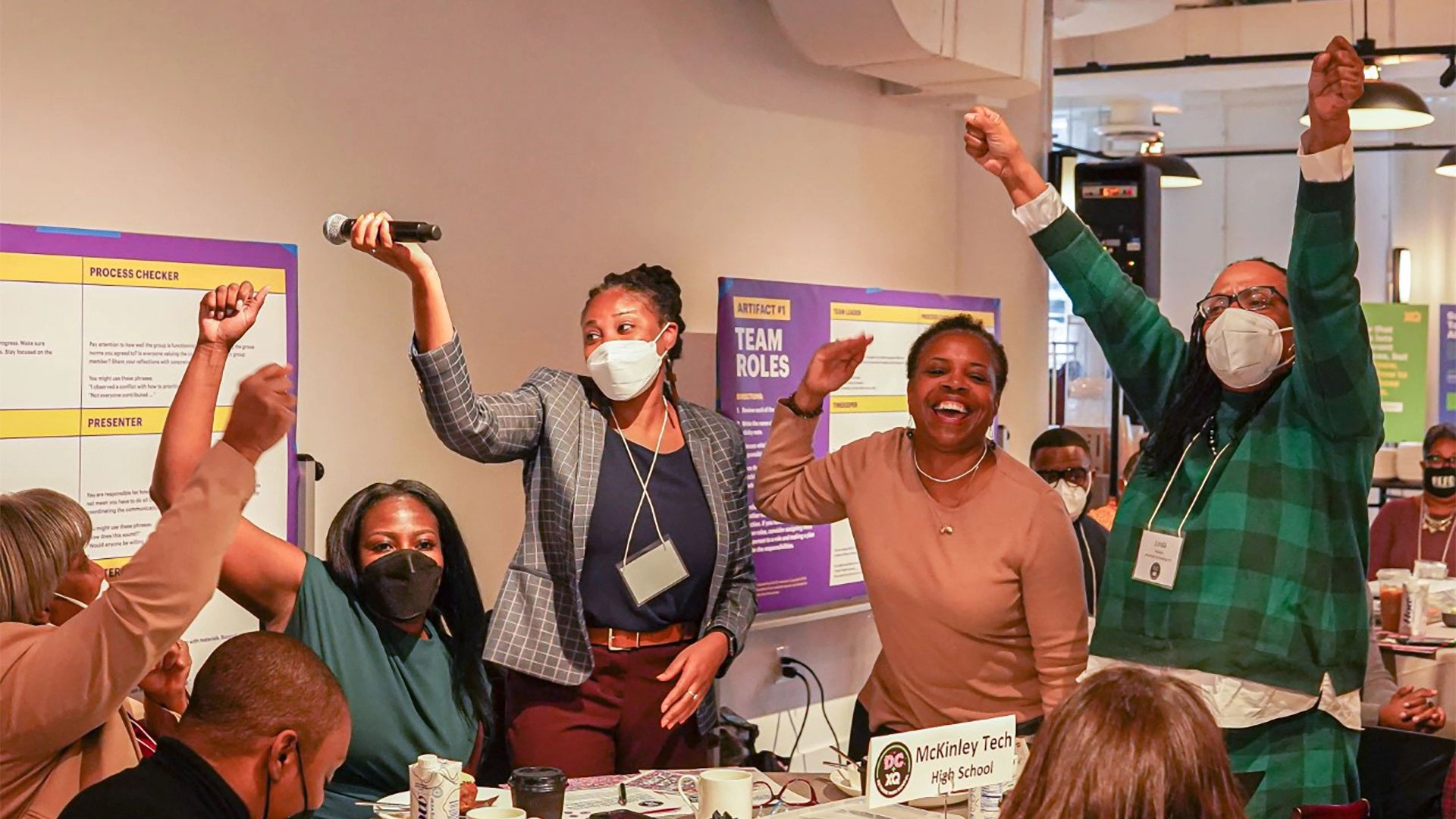Much More Than a Road Trip: 5 Groundbreaking Schools Inspire DC+XQ Teams
Many schools looking to transform high school do not know what community-focused, student-centered high school looks…

Many schools looking to transform high school do not know what community-focused, student-centered high school looks like in action. As part of XQ’s design process—a process that helps schools identify barriers to equity and design solutions to better support all students—we send design teams to visit high schools where that transformation is already underway.
These “Inspiration visits” are an opportunity for schools beginning to rethink education to see and feel what’s possible by engaging with young people, faculty, and programming at XQ schools.
XQ’s partnership with the District of Columbia Public Schools (DCPS) asks communities to rethink what it means when high schools serve all learners and make those visions a reality. This is why each of the city’s high schools has a design team with community members. Recently, the DC+XQ teams traveled across the northeast and midwest to get inspired—to see schools already reimagining what high school can be.
This road trip was a chance for DC high schools to see firsthand how to break the mold of traditional education, to learn what works and what doesn’t, and to bring new insights into their unique school designs. “We always say that ‘seeing is believing,” explained XQ Senior Advisor Anne Mackinnon, “so there’s no better way to inspire a school design team than to let them experience for themselves some truly bold high school models.”

From Our Nation’s Capital to Michigan, Tennessee, New York, and Indiana
Each DCPS high school design team got to visit up to two schools working on the ground to make more equitable education a reality. These included four XQ schools—Washington Leadership Academy (Washington D.C.), Grand Rapids Public Museum School (Grand Rapids, MI), Crosstown High (Memphis, TN), and Purdue Polytechnic High School (Indianapolis, IN)—as well as Brooklyn STEAM, an innovative high school that’s part of XQ’s partnership with the New York City Department of Education. These five schools previously participated in a design journey with XQ. Their design teams and school leaders know firsthand what it takes to transform their ideas into reality.
“The ultimate goal of these inspiration visits is to do exactly that: inspire,” explained XQ Head of Partnership Expansion Jeanie Lee. “Design teams have deep exposure to design theory and thinking. We hope that by bridging teams with schools that have already gone through the design process, and now fully operating their models, they can connect the dots and go bolder with their own school designs.”
“We’ve been saying from the beginning of the design journey: without constraints, what would you do to reimagine high school?” added XQ Project Manager Zoe Lewis. “We hope these visits help participants think big and bold.”
Over 90 design team members from 10 DCPS schools attended inspirational campus tours, sat in to observe classrooms, met leaders and educators, and heard from a panel of current students.
The DC+XQ schools in attendance included: Bard High School Early College DC, Benjamin Banneker High School, Cardozo Education Campus, Columbia Heights Education Campus, Coolidge High School, Dunbar High School, H.D. Woodson High School, Jackson-Reed High School, McKinley Technology High School, and Ron Brown High School.
The trips were strategically timed before the DC+XQ Cohort 1 application deadline so school teams could explore their ideas in the context of actual examples, get advice from experienced educators, and gather actionable lessons to apply to their emerging school designs.
Work-Based Learning at Brooklyn STEAM Center
Some schools offered specific guidance around different approaches to learning. For instance, Brooklyn STEAM offered design teams an up-close look at meaningful and engaged learning with a focus on STEAM education—an approach to teaching and learning that combines science, technology, engineering, the arts, and math to guide student inquiry, discussion, and problem-solving.
Brooklyn STEAM Center is located in the Brooklyn Navy Yard, a 300-acre waterfront industrial park. This location allows 11th and 12th graders to get hands-on technical, professional, career, and financial skills to prepare for real-world economic opportunities and design their future.
The school embraces student-centered learning and asks students to guide their learning by choosing their preferred pathway: construction technology, design and engineering, film and media, computer science and IT, or culinary arts and management. These students then spend part of their day in work-based learning through an internship with one of the 400-plus businesses right there in the Navy Yard.
The visit to Brooklyn STEAM helped design teams see what it means to create an engaging learning experience for students. The visit helped teams understand how practical classroom projects reinforce math, science, literacy, and arts concepts. Engineering students, for example, build a tiny house on-site, measuring angles, using power tools, and ultimately walking away with relevant industry certifications.
Paul Abdou, math educator at Cardozo Education Campus in Washington, D.C., said the trip made him and his colleagues reconsider the purpose of education. “The whole conversation has shifted,” he explained. “Right now it’s ‘we require you to pass algebra 2 to get your diploma.’ At Brooklyn STEAM, they’re saying ‘these are the tough workplace problems we need to solve, and these are the math problems you need to solve them.’”
“It was inspiring to see a school so in touch with the economic needs of a community and very intentional about meeting those needs while also delivering a top-notch education in an intellectually rigorous way,” he added.
Brooklyn STEAM’s approach resonated with members of Cardozo’s leadership team. Because the D.C. school serves students who have experienced generational poverty, “having a school that prepares students to become business owners tears down barriers that government agencies and institutions failed to recognize,” said Cardozo Principal Arthur Mola.
More than that, the visit showed the Cardozo team why it is important to build a student-centered culture and foster meaningful relationships in the school. “Kids are never late [at Brooklyn STEAM],” explained XQ’s Lee. “They always show up. They enjoy being there and every one of them can attest to how trusting relationships support their learning but also their growth journeys as young people.”
The Cardozo cohort returned home to DC with the energy to build a school that can place students at the center of their community-business partnerships, and ensure that they give students authentic networking opportunities.
Purdue Polytechnic Showcases Student Inspiration
The D.C. teams visited other schools that showcased what it means when schools are reimagined to solve specific problems and engage with community partners. For instance, the design team of Purdue Polytechnic High School—an XQ school located in Indianapolis, Indiana—worked to design a school that creates a seamless transition to college and high-wage STEM jobs. Founded in 2017, PPHS has equipped many first-generation college students to thrive through hands-on projects and industry partnerships (recent ones include Subaru, Republic Airlines, and United Way).The results show success: PPHS has tripled the number of students of color from the Indianapolis Public School District who attend Purdue University, starting with its first graduating class in 2021.
XQ’s Lewis joined the PPHS visit and met a group of current students who exemplify the motivation to advance in life and work. “All the students on the panel said that to succeed, they need to feel a sense of urgency, and they all got that from Purdue teachers and their support,” she said. “But now the urgency also comes from within.”
Sharona Robinson, a DCPS parent, staff member, and member of the McKinley design team walked away from the PPHS visit with renewed energy to be bold. “If the pandemic has done nothing else, it’s taught us that we need to teach and think differently,” said Robinson. “School doesn’t have to be the traditional ‘sit in front of an instructor and be talked at for the majority of the day.’ It can be work-based, online, and through mastery and not just hours.”
After visiting a robotics classroom and yoga studio at Purdue, Robinson said, “Light bulbs went off for McKinley.” It helped her realize not only that schools can create opportunities for students to engage in learning outside of the classroom, but she saw examples of how to do just that as well.
What’s Next for the DC+XQ Design Teams
These visits will not only inspire bold school redesigns for the DC+XQ cohort, but they will also give participants a network of school leaders across the country who have completed the same process. XQ’s Lewis explained, “They’re going to face a lot of the same challenges even if their school models are wildly different. I hope this gives them someone to talk to.”
Inspiration visits are a crucial part of the XQ approach and the design journey. Cardozo Principal Mola said he got a lot out of the trips, even more than he expected. “I came in slightly skeptical about how this redesign work actually goes into effect,” he acknowledged. But after the visit, he said, “I saw good examples of what a school can be when there’s a unifying element that grounds everybody in commitment and dedication. It was clear that they prioritize building relationships with their students while they have their instructional priorities.”
Six schools have submitted applications to join DC+XQs first cohort, and others are preparing to apply for the next round. Stay tuned for more updates on the DC+XQ partnership.









